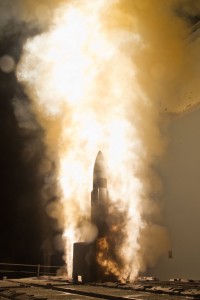With the North Korean nuclear weapons test a keen reminder of the challenges of the 2nd nuclear age, the need to get missile defense right is increasingly pressing.

Getting the SM-3 missile to intersect with the capabilities of the coming fleet of F-35s will allow an extension of Aegis reach and make the “Aegis my wingman.”
http://www.usni.org/magazines/proceedings/2012-01/long-reach-aegis
https://sldinfo.com/understanding-the-challenge-of-deterring-north-korea/
Recently, the Navy tested the latest version of the standard missile. And according to the USN press release here are the results:
Flight Test Mission-20 successfully demonstrated again the system’s capability to detect the target from outer space and launch a sea-based Standard Missile from an Aegis-equipped Navy ship, all based on track data from satellite sensors orbiting Earth. ”This was a great feat for our Navy and our nation as we move forward in the next step of ballistic missile defense,” said Capt. Eric Ver Hage, commanding officer of the Naval Surface Warfare Center, Corona Division, a Naval Sea Systems Command field activity in Norco, Calif. “As a former ship CO, it’s awesome to see the collaborative assessment team here at the Joint Warfare Assessment Lab supporting ships at sea.”
With the extended sensor network from space, MDA and Sailors aboard USS Lake Erie (CG 70) executed the Launch on Remote doctrine and destroyed the target with Standard Missile-3 Block 1A (SM-3 1A) guided missile.
The missile vaporized the target following a direct-hit minutes after its launch from the Pacific Missile Range Facility on Kauai, Hawaii, at 4:10 a.m. (EST). For the test, NSWC Corona installed a mini-KU band antenna aboard Lake Erie to transmit large amounts of performance data from the cruiser’s second-generation Aegis weapon system to the Navy’s JWAL in Southern California. There, the assessment team of program managers, industry and analysts from warfare center divisions at Corona, Port Hueneme and Dahlgren provided remote analysis of the flight experiment.
The small, portable antenna reduced data transmission time from days to an hour – significantly shortening feedback time to ships at sea and enabling rapid assessment and feedback that is essential to helping MDA meet emerging threats, Ver Hage said. According to MDA, the threat of a ballistic missile reaching either the U.S. or forward deployed forces – especially one armed with a weapon of mass destruction – benefits most from a layered defense that utilizes both sea- and land-based interceptors and radars, as well as space-based sensors. All branches of the Armed Forces play a role.
To counter future projected threats, the advanced capability of MDA’s space tracking system demonstrators extends the battlespace and provides the ability for longer range intercepts and defense of larger areas. The defense agency demonstrated the first successful use of its space-based sensors in April 2011 during FTM-15, when the STSSD satellites successfully acquired the target missile and provided stereo “birth to death” tracking of the target. ”Integration of space-based sensors into the next-generation defense system allows for detection and tracking of threats up close and over a much larger area than ground-based assets alone,” said MDA spokesman Rick Lehner.
He added, that by using different space-, land-, and sea-based assets operated by multiple Services, the Combatant Commanders have the best sensor information on a threat’s location and a more diverse and effective set of weapon options to defeat an attack. The unified Command and Control, Battle Management, and Communications system connects all the components, he said.

